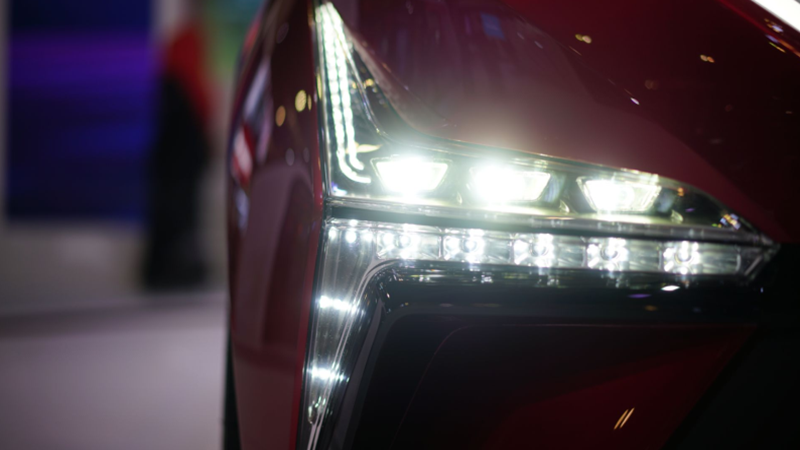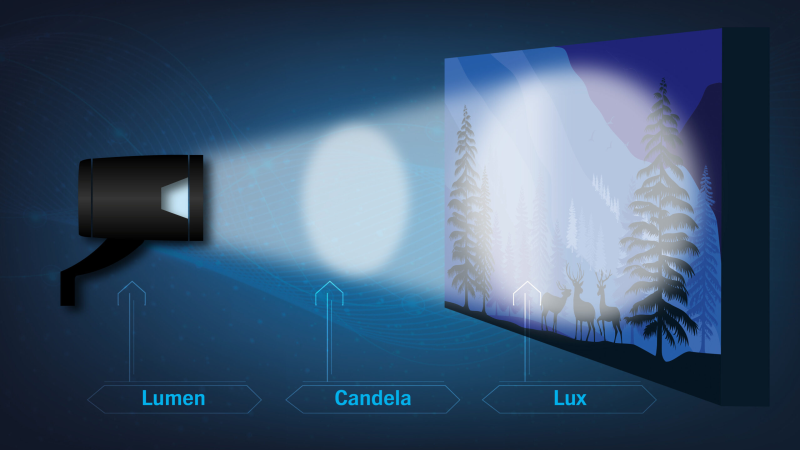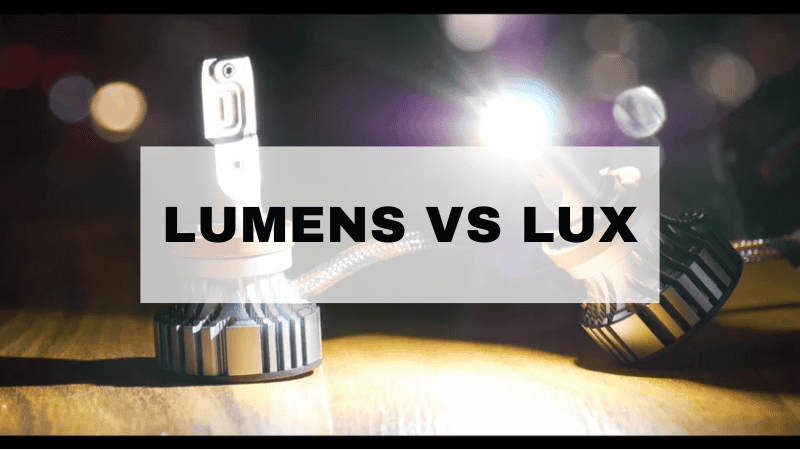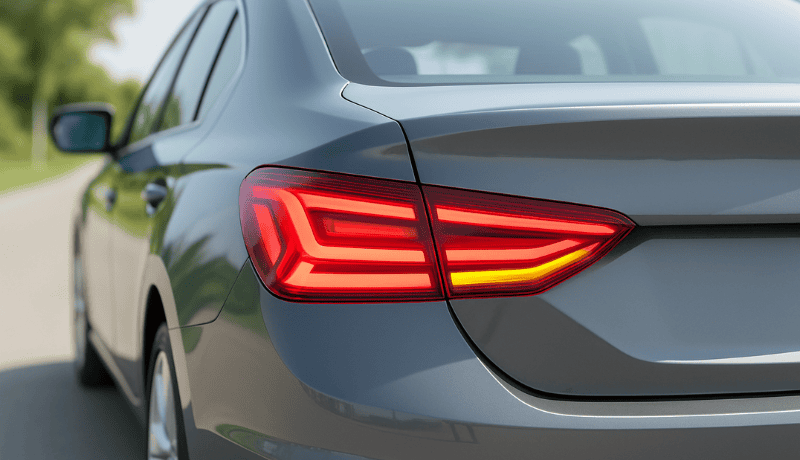Lumens and lux—these two lighting terms sound similar. However, understanding their difference is crucial for the perfect lighting atmosphere. Selecting the appropriate lighting demands a basic understanding of illuminance, measured in lux and lumens.
This blog covers the introduction, relationships, and differences of these lighting units. We will also discuss their practical applications in automotive lighting.
By reading this blog, you can make informed choices for diverse lighting solutions for various purposes based on lumens and lux. Here we begin!
What is Lumens?

Lumens is the unappreciated hero of the lighting world. Before the introduction of lumens, watts were the main unit used to measure the brightness of the light sources. But that changed after Lumens took all the spotlights.
Lumens are scientific units for measuring the “total amount of light output or light emitted by a source,” denoted by “lm.” The increase in the lumen means the increased brightness of light.
It specifically measures the brightness perceived by the human eye, taking into account the sensitivity of the human eye to different wavelengths of light.
In contrast, watts only measure total energy consumption instead of brightness. For example, the LED light bulb is a light source that consumes less energy (watts) than traditional incandescent bulbs while giving equal or even higher lumens (brightness).
Measurement of Lumens

There is no direct way to measure the lumen. Instead, we calculate it by using a device known as an integrating sphere during a complex procedure.
This procedure involves placing a light source, such as a headlight or a bulb with a highly reflective internal coating, inside a hollow sphere. Then, it captures the light emitted and bounces it in all directions inside the sphere with the help of a reflective coating.
It helps capture as much of the light as possible. Many tiny sensors present on the inner surface of the sphere measure the intensity of reflected light on various points.
Thus, this sophisticated software calculates the total amount of visible light emitted by the directional light sources at different points.
Significance of Lumen in Automotive Headlights

The automotive headlights industry uses lumens to improve nighttime visibility and safety. Higher lumens subject to the brighter headlights, mean more light illuminating the road area.
However, there are regulations governing the allowance of the maximum lumen for headlights because overly bright headlights cause blinding to oncoming drivers.
Significance of Lumens in Interior Lighting
Lumen plays a pivotal role in creating the desired atmosphere in interior lighting. A dimly lit area with lower lumens nurtures a cozy ambiance. In contrast, a well-lit interior with more lumens fosters productivity and alertness.
Proper illumination by a directional light source with optimal comfort and functionality is achieved by understanding lumen requirements for specific needs.
What is Lux?

The critical metrics for evaluating the luminous flux by a light source are usually measured in lux. Lux is the scientific unit for measuring illuminance, which means the total light output of light that falls on a surface, denoted by “Ix.”
For example, if a lumen hints at how bright a lamp is, then a lux shows you how much light reaches you.
Measurement of Lux
A handy tool known as a “lux meter” is used to measure luminous flux. This device consists of a light sensor that converts the intensity of the light into an electrical signal.
A special filter is placed before the sensor to imitate the human eye’s sensitivity curve. A small computer within this meter processes electrical signals from the sensor.
Thus, consider the filter’s effect and convert the signal into a lux rating using the formula lumens per square meter.
Hence, the processed signal with a direct reading of luminance or lux appears on the meter’s screen. The lux meter measures the light intensity, the filter adjusts it according to human discrimination, and later, the electronics convert it into a lux value.
Significance of Lux in Automotive Headlights

Lux is a key factor in assessing the quality of headlights, as factors like lens shape, road conditions, and the headlight design all impact how much light falls on the road ahead.
The measurement of the effectiveness of headlights through lighting lux at different points on the road illuminated by the lights emitted by headlights.
The higher readings on the road mean better visibility for the driver and are mandatory for pinpointing risks, e.g., pedestrians or animals at night.
Lux readings translate the headlight’s desired beam pattern to ensure proper light distribution. However, weather conditions like rain or fog can greatly affect and reduce lux lumens levels.
Practical Applications in Automotive Lighting
Lux lumens are crucial in automotive lighting to ensure safety in nighttime driving. The combined working of these metrics is vital for safety and optimal visibility on the road.
Lumens is the total light measurement by a light source or the total amount of light emitted. Meanwhile, lux means the illuminance or the amount of light present on a particular surface.
Engineers create effective and dynamic lighting systems by understanding the balanced working area of lumens and lux for better visibility and safety.

Engineers use headlights with high lumens to attain good lux for drivers on the road ahead, balancing lumens and lux. In addition, they strategically position low-lumen fog lights to improve lux in low-visibility conditions like fog or rain.
Lighting technologies like high-lumen LED automotive lighting offer more light and consume less energy compared to a light bulb’s brightness. They also allow the design of complex headlights with multiple LED chips to attain optimal lux distribution.
Automotive engineers equal the balance between lux and lumens through:
- A high beam of headlights exhibits lumens to light far objects to ease driver’s visibility.
- The sensors adjust headlight beam patterns in real-time through advanced systems. They also control visible light present by measuring lumens and lux in specific areas.
- Certain regulations apply to specify minimum lux and lumens for different types of headlights. These regulations ensure proper safety and visibility for all vehicles on the road.
- DRLs (daytime running lights) are installed to provide good visibility over illumination by emitting low-lumen light with a pattern of lux to get the car noticed.
- Fog lights are designed specifically for low-visibility purposes with lower lumen amounts. The placement of the lumen on the bumper achieves high lux in the fog, improving visibility.
Relationship between Lumens & Lux

The relationship between a lumen’s lux is described as “One lux (1 lux) is equivalent to one lumen per square scattered over an area of one square meter”. In other words, lux gives an idea to you about how much light there is to illuminate a given area.
Hence, 500 lumens, which measures an area of one square meter, is the amount of light visible in that area with 500 lux.
The 500 lumens for an area of 5 square meters illuminate 100 lux. Increasing the number of lighting fixtures illuminates a larger area with the same amount of lux levels and larger lumens.
Therefore, the high-power light fittings in automobiles offer more brightness and cover considerable areas without any issues.
The power consumed to operate an installed light fitting is measured as rated wattage, which refers to the entire power used to create the light lumens.
“Luminous efficacy is a light engineering term for measuring the rate at which a lamp converts power (watts) into light.” It is denoted by lumen per watt(LPW) or per circuit watt. It measures the efficiency of a light source producing visible light.
FAQs

- Can higher lumens always guarantee better visibility in automotive lighting?
A high lumen does not guarantee better visibility. Lux (light distribution or how much light) is also important for good visibility in automotive headlights.
- How do manufacturers balance lumen and lux when designing car lights?
The manufacturers designed car lights to balance the lumen (output emitted light) with reflector designs for good lux (road illumination).
- What are typical lumen and lux values for car headlights?
It varies with the type of headlights; however, low beams usually range from 700 to 1200 lumens. Lux depends on the distance and design.
- Are there legal limits on lumens and lux for car headlights?
Fewer legal limits for car headlights mainly focus on candela (measures light intensity instead of lumen (light output) or lux (illumination on a particular surface). These limits ensure headlights are bright enough not to cause blinding.
Conclusion
Lumens (lm) and Lux (lx) are two scientific units that work together to achieve optimal lighting. Lumens help with the total amount of light emitted on a surface, while Lux measures the luminance of light output. The key is to balance the two for optimal light and safety, either at home or on the road.
High lumens facilitate brighter beams, but good lux distribution facilitates the whole surface’s appearance. So, whenever you choose lights, remember the lumen for optimal brightness and lux to measure luminance.
Visit Carlightvision for High-Quality Automotive Headlights
Carlightvision manufactures high-quality automotive headlights tailored to perfection by maintaining lumens and lux. Our team of experts is always here to guide you about the perfect light for your vehicle.
Contact us for more details and queries about automotive headlights to illuminate your life journey!




